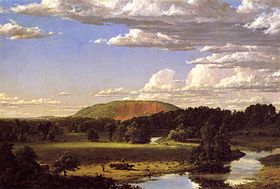West Rock
| West Rock Ridge | |
|---|---|

West Rock, New Haven by Frederic Edwin Church, 1849
|
|
| Highest point | |
| Elevation | 700 ft (210 m) ridge high point |
| Coordinates | 41°24′56″N 72°56′17″W / 41.41556°N 72.93806°W to 41°19′57″N 72°57′41″W / 41.33250°N 72.96139°W |
| Geography | |
| Location | New Haven, Hamden, Woodbridge, and Bethany, Connecticut |
| Parent range | Metacomet Ridge |
| Geology | |
| Age of rock | 200 Ma |
| Mountain type | Fault-block; igneous |
| Climbing | |
| Easiest route | Auto road |
West Rock Ridge or West Rock of south-central Connecticut, with a high point of 700 feet (213 m), is a 7-mile (11 km) long trap rock mountain ridge located on the west side of New Haven. The ridge forms a continuous line of exposed cliffs visible from metropolitan New Haven and points west. West Rock Ridge is part of the narrow, linear Metacomet Ridge that extends from Long Island Sound near New Haven, north through the Connecticut River Valley of Massachusetts to the Vermont border.
West Rock Ridge is popular for recreation and known for its microclimate ecosystems, rare plant communities, and expansive views from cliffs that tower up to 500 feet (152 m) above the surrounding landscape. The ridge is traversed by a network of hiking trails including the 7-mile (11 km) Regicides Trail and the southern terminus of the 23-mile (37 km) Quinnipiac Trail.
Judges' Cave and the Regicides Trail (which traverses the length of the ridge), receive their names from two judges Edward Whalley and his son-in-law William Goffe, who had signed the death warrant of Charles I of England in 1649. After the restoration of the monarchy with Charles II of England in 1660, the pair of regicides fled to the area to avoid arrest and hid in a boulder cave on the crest of the ridge intermittently over the summer of that year.
Other notable historic events include the portrayal of the ridge by 19th century landscape painter Frederic Edwin Church in 1849 and numerous paintings by George Henry Durrie.
...
Wikipedia
